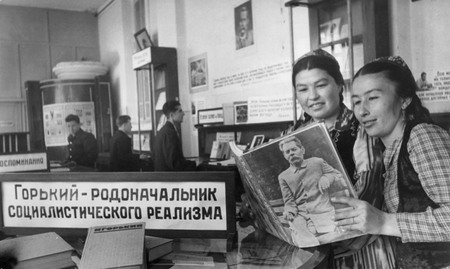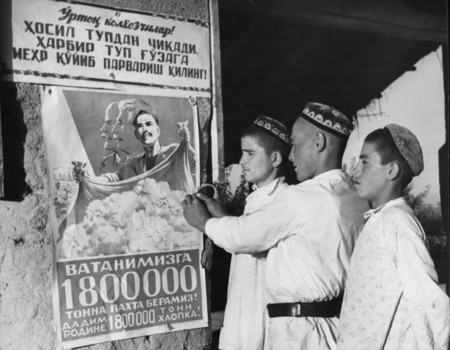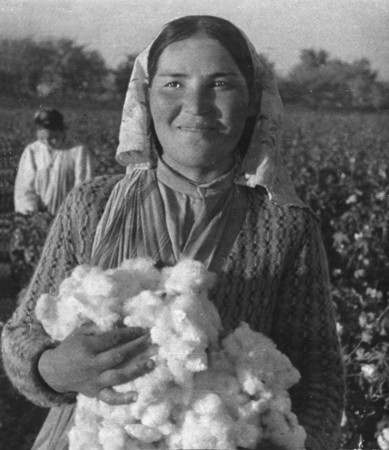Retrospective



















Max Penson. Pioneers. 1930-1940’s. Collection of the museum “Moscow House of Photography”
Max Penson. No title. Uzbekistan. 1930’s. Collection of the museum “Moscow House of Photography”
Max Penson. Painter Hazanova. 1940. Collection of the museum “Moscow House of Photography”
Max Penson. Maxim Gorky - father of socialist realism. 1930-1940’s. Collection of the museum “Moscow House of Photography”
Max Penson. Demonstration. Uzbekistan. 1930-1940’s. Collection of the museum “Moscow House of Photography”
Max Penson. No title. Uzbekistan. 1930-1940’s. Collection of the museum “Moscow House of Photography”
Max Penson. Kindergarten. 1930-1940’s. Collection of the museum “Moscow House of Photography”
Max Penson. No title. Uzbekistan. 1930-1940’s. Collection of the museum “Moscow House of Photography”
Max Penson. Kolkhoz sanatorium. Kolkhoz named after Kalinin. Altinkulsky district of Andijan region. 1930’s. Collection of the museum “Moscow House of Photography”
Max Penson. Lunch cooking for tractor operators of “Pakhta-Aral” sovkhoz. 1930-1940’s. Collection of the museum “Moscow House of Photography”
Max Penson. No title (radioshack). Uzbekistan. 1930-1940’s. Collection of the museum “Moscow House of Photography”
Max Penson. Irrigation of cotton fields. 1937. Collection of the museum “Moscow House of Photography”
Max Penson. Kolkhozniks on the road to Big Fergana channel construction. 1930’s. Collection of the museum “Moscow House of Photography”
Max Penson. Soil irrigation. Storage filed. 1937. Collection of the museum “Moscow House of Photography”
Max Penson. First step. 1950. Collection of the museum “Moscow House of Photography”
Max Penson. Ground irrigation. 1939. Collection of the museum “Moscow House of Photography”
Max Penson. Portrait of a woman. Uzbekistan. 1930’s. Collection of the museum “Moscow House of Photography”
Max Penson. No title. 1930’s. Collection of the museum “Moscow House of Photography”
Max Penson. Textile plant in Tashkent. 1940. Collection of the museum “Moscow House of Photography”
Share with friends
Within the framework of the festival “ACT 2006: New Russian arts in London”
The Gilbert Collection
For the press
For many years the name of Max Penson remained practically unknown in the world, but in reality his works deserve to be mentioned alongside those of Alexander Rodchenko and other great Soviet Photographers of the 1920s and 1930s.
Max Penson was born in 1893 in Velizh near Vitebsk, the latter city being the birth-place of Marc Chagall. After learning to read and write completely on his own, in 1907 he entered the Velizh Town School which he finished in 1911. He later studied at the College of Art and Industry of the Antokolski Society in Vilno (now Vilnius, Lithuania).
In 1915 the outbreak of World War I and the rising wave of Jewish pogroms forced the young artist to move to Middle Asia, to the town of Kokand. In Uzbekistan Max Penson worked for some time as an accountant and taught drawing at local schools.
In 1921 Max Penson was presented with a camera. This event changed his life. He almost entirely ceased to paint and draw, and tried to master the technique of photography.
In 1923 Max Penson moved to Tashkent, where he would spent a lot of time with local professional photographers, who had their own studios. However he himself got increasingly interested in the genre of photo-report.
From 1926 to 1949 Max Penson worked as a photographer for the Newspaper «Pravda Vostoka» («Truth of the East»), creating a unique photo-chronicle of Uzbekistan.
All these years his photographs were not only published daily in his newspaper, but, through the TASS (Telegraph Agency of the Soviet Union) Agency, appeared in various illustrated editions of the country, including the legendary magazine «USSR under Construction». One of its issues (1933, No 10) was based almost entirely on works by Max Penson. With all the numerous publications, however, the photographer, who scarcely ever left Uzbekistan, remained alienated from the intense exhibition activities that in those years were taking place in Leningrad and particularly in Moscow. As a result he was not represented at foreign exhibitions, where people like Alexander Rodchenko and El Lissitzky showed their works. Only in 1937 his photo «Uzbek Madonna» was awarded a gold medal at the Paris World Fair.
In those years a photographer who worked for the press was expected to hand over to the publishers just a small print, which did not demand any artistic improvements. In this light it is interesting to note that for more than a quarter of a century Max Penson daily made for his own personal use large exhibition prints, experimenting with different techniques. The results turned out to be quite fascinating and could finally be appreciated only in the late 1980s, when his archive was rediscovered. Becoming a photo-reporter, Max Penson, who was a real workaholic (the extant archive has some 50 thousand negatives), remained an artist throughout his life, an artist, whose goal was not just to record the radical changes that took place in Uzbek life. His ambition was, rather, to turn each shot into an artistic metaphor, giving it perfect aesthetic form.
His oeuvre was influenced not just by the leaders of Soviet photography of the 1920s and 30s — both Pictorialists and Modernists, whose works he could see in print, but also by the experience of earlier painters. He never parted with catalogues reproducing masterpieces of the Italian Renaissance, particularly admiring Michelangelo, as well as the famous 18th and 19th century artists of the French School.
Uzbekistan, which joined the Soviet Union in 1924, became a second home-land for Max Penson. He had a perfect knowledge of both local language and history. Returning from the shooting of a movie (which was never completed) about the Grand Fergana Canal, Sergei Eisenstein wrote: «it is impossible to talk about Fergana without mentioning the omnipresent Penson, who crossed Uzbekistan back and forth with his camera. His archive, unique in every way, contains materials which give us an opportunity to follow one of the historical periods of the republic year by year, page by page. The artistic development of Max Penson, his whole life were connected with this remarkable country».
In the 1920s-1940s Middle Asia, and primarily Uzbekistan, was an important theme for Soviet ideological propaganda. The transition from feudalism to socialism, which happened in so brief a period in this Soviet Republic, was expected to illustrate the infinite potential of the new power. Uzbek women, who took off their yashmaks and began to do sports and military exercise, the fight against illiteracy, traditional agriculture being replaced by industry — all these achievements, often reached with brutal means, were to be visually recorded and presented before the populace, supporting the faith in the demiurgic nature of the Soviet system. This is why crews of the best Soviet cinematographers and photographers were regularly sent to Uzbekistan — among the latter were Max Alpert, Alexander Khlebnikov, Arkadi Shaikhet and Georgi Zelma.
Max Penson was unique, because he was a photographer, who witnessed all these changes in Uzbekistan from within. This is why his subjects are so amazingly varied, just as his aesthetic, when he chooses the exactly adequate approach and form for each of his shots. Looking at Penson’s oeuvre, one can easily follow the evolution of Soviet photography in the 1920s and 1930s — from Pictorialism and Modernism to Socialist Realism.
Penson uses the Pictorial manner to shoot subjects that are related to Uzbekistan’s history. These are: digging irrigation canals, which in Soviet Uzbekistan was done just the way it was centuries ago — with the help of a hoe; national games and celebrations; portraits — mainly of old men, the last defenders of traditional customs. The aesthetic of Pictorialism, which was persecuted in the 1930s primarily for its preoccupation with the past, with preserving individual and historical values, was disliked by the authorities as something opposing the new myths, the faith in the «bright future». However Max Penson continued turning to it until the late 1930s.
«New» Uzbekistan, on the other hand, connected not only with industrialization bur also with the process of introducing an unprecedented form of collective mentality, is portrayed by Max Penson with all the splendid innovations of Soviet Constructivism. Diagonal composition, close-ups and innovative positioning of the camera are used by the photographer in total harmony with the immanent logic of Modernism. Penson sincerely shares its enthusiasm for reshaping society, at least he appears to be until the mid-1930s.
Among the many Soviet myths one of the most important was associated with sports and the militarization of the country, which were closely connected with one another. Athletic subjects were popular with all Soviet Modernist photographers, and Penson was no exception. They gave the opportunity, on the one hand, to avoid staged photo-report, which became the principle genre as early as the mid-1920s, and, on the other, it hypnotized the viewer, like in the case of any totalitarian regime, with the colossal energy of collective will.
As the totalitarian system in the USSR gained strength, the authorities began imposing Socialist Realism everywhere, most of all, on photography. Censorship and self-censorship started influencing the works of all Soviet artists without exception, including Max Penson. In photographs like «In the Meeting Hall of the Central Executive Committee of Uzbekistan» (1935) or «On the Veranda of the Sanatorium in Shakhimardan» (1932) he is clearly preoccupied with the problem of light — real, physical light, and metaphysical light illuminating new life. But in «Mother and Child Sanatorium in Bukhara» (1935) we see a different picture — the author is painstakingly trying to visualize alien ideological principles of Socialist Realism. Uzbek women with babies, in the midst of a splendid spring garden, are portrayed at the foot of an enormous monument to Lenin and Stalin, sitting side by side. It is interesting to note that this sculpture, reproduced in millions of copies across the enormous territory of the Soviet Union, was inspired by a photograph, which in turn was created with the help of retouch and montage, and in fact it was the only photograph of this type that was allowed to be reprinted in all the text-books on Soviet history. The images of Lenin in a wheelchair, photographed at the end of his life, when he was in reality a prisoner in his Gorki residence, and of Stalin, resting in a wicker chair, were expected to symbolize the continuity of Soviet power, canonizing the friendship of the Bolshevik chiefs, when Lenin’s myth was needed to support and enforce Stalin’s cult.
The picture of the Uzbek mothers, who, without yashmaks, are feeding babies at the foot of the monument to the two political chiefs, was meant to become a symbol of the liberation of Eastern women from the age-old religious and social oppression. The representation of these global symbols, combined with an attempt to use a compositional scheme typical for classical art, leads to such deplorable results, that we can hardly believe that this shot was made by Max Penson at the peak of his artistic career. This photograph is symbolic in itself as an example of the painful forced birth of Socialist Realism aesthetic.
Max Penson’s son Miron, himself an outstanding cinematographer and photographer, remembered how in those years his father would light nightly fires in his garden, throwing into the flames the negatives and prints of those men and women, who were crossed out of life by Stalin’s regime. Alas, this precautionary measure was not enough. After the war the Soviet authorities launched a campaign against cosmopolitism, and finally the new anti-Semitic wave reached Uzbekistan. In 1949 Max Penson’s photographic license was withdrawn and he was fired from the newspaper where he had worked for more than twenty years.
During the last ten years of his life, until 1959, Penson, very depressed and seriously ill, was engaged in retouching his photographs. This is how a new variant of the subject «Propaganda Cart in the Collective Farm Named after Molotov» appeared. On the one hand, this retouching, affecting a large part of his archive, was something absurd, because it was applied to those shots which were printed in the 1930s and which would no longer be accepted by the Soviet press of the two subsequent decades. On the other hand, it strangely reminds one of the drawings of Ilia Kabakov, the master of Soviet underground art and one of the creators of the so-called «sots-art» aesthetic, famous for his ironical treatment of Soviet myths. Censorship and self-censorship taught the Soviet people to keep silent. Max Penson also kept silent, even when he was alone with his family. But this odd drawing over his own prints, that transformation of serene, spiritual personages into pasteboard monsters was, it seems, a form of defense reaction, the only way to reflect on the tragic experience of his collapsing hopes and beliefs. These beliefs, which nourished his work in the 1920s and 1930s, existed only for the period of time when Russian Modernism found inspiration in the new ideological slogans of the Bolsheviks, the latter launching their own process of modernization. For them Uzbekistan was a sort of a testing area, where «innovative» measures of the Soviet regime were particularly radical, leading to visibly «outstanding» results.
For several decades the oeuvre of Max Penson vanished from the history of Soviet photography, just like the first leaders of the Soviet Regime, later labeled «enemies of the people», whose portraits he burned, disappeared from history books.
In 1966 Max Penson’s archive was buried under the remains of a building destroyed by a terrible earth-quake. The whole of Tashkent was lying in ruins. The archive was saved owing to the heroic efforts of Dina and Faizulla Khodzhaev, the photographer’s daughter and her husband. In 1996 Max Penson’s works were shown in Switzerland, and in 1997 the Museum «Moscow House of Photography» organized another exhibition in the Paris Gallery «Carré Noir». Since then Penson’s works are often shown in Russia and Uzbekistan, as well as in various American and European museums and galleries.
The exhibition «Modernism: the New World Designed.
Olga Sviblova, Director of the Museum «Moscow House of Photography»


